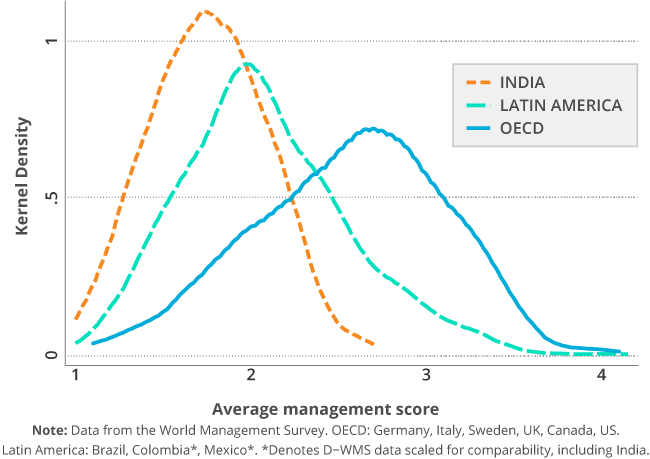
The Development World Management Survey is an expanded survey tool to measure the quality of management practices at schools and hospitals in developing countries.
While the D-WMS keeps the essence of the WMS ensuring backwards compatibility, we adapted the tool to make it applicable in the development setting by addressing the following challenges to using the original WMS in developing countries.
CHALLENGE 1:
Thick left tail
The distribution of scores in the education sector tends to be tight around the scores for weak management practices. Although the global context of the WMS project allows for a very useful comparison of world-class and poorly managed organizations across a number of countries, the very thick (almost truncated) left tail for developing countries makes it harder to explore the variation of managerial practices in the less well managed organizations.
The D-WMS…
… allows for the systematic expansion of the possible scores to half points from full points, with specific instructions on what falls into each half point category.

CHALLENGE 2:
FEASIBLE IMPLEMENTATION
The distribution of scores in the education sector tends to be tight around the scores for weak management practices. Although the global context of the WMS project allows for a very useful comparison of world-class and poorly managed organizations across a number of countries, the very thick (almost truncated) left tail for developing countries makes it harder to explore the variation of managerial practices in the less well managed organizations.
The D-WMS…
… includes field forms and a survey protocol such that it is possible to carry out these surveys on the field in a face-to-face interview in a comparable manner.
CHALLENGE 3:
POLICY FOCUS
The distribution of scores in the education sector tends to be tight around the scores for weak management practices. Although the global context of the WMS project allows for a very useful comparison of world-class and poorly managed organizations across a number of countries, the very thick (almost truncated) left tail for developing countries makes it harder to explore the variation of managerial practices in the less well managed organizations.
The D-WMS…
… allows for the systematic codification of the different information that went into a single WMS score into a more detailed analysis of the types of processes that are in place and which are opportunities for improvement. For example, we saw many schools that had brilliantly filled out report cards (a high score in the implementation process of the data-driven practice) but they lived in the corner of the principal’s office, stacked and unused (a low score on the usage and monitoring processes of the data-driven practice).

